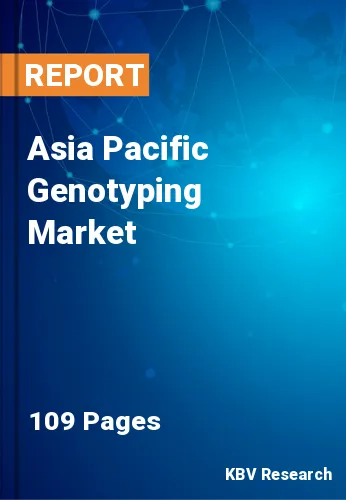The Asia Pacific Genotyping Market would witness market growth of 15.2% CAGR during the forecast period (2022-2028).
Genotyping at the nucleotide level eliminates both gene expression noise and any other methodological 'proxies' from the process. The single-nucleotide polymorphism (SNP), which represents a fundamental unit of diversity, is a basic unit of this genotyping technique. SNP markers often have two alleles, making them a biallelic genotyping locus. Since single SNP loci only contribute a tiny amount of information for distinguishing between isolates, they are often used for motivated by self - interest only if they are coupled with high-value information.
Within a species, genotyping is used to distinguish isolates. Genotyping can also be used to characterize a single allele, such as determining the presence or absence of a gene, when the result is binary. In addition, a single allele can be evaluated for its nature or sequence, resulting in a variety of results, such as nucleotide sequences or banding patterns. Multiple alleles can be mixed as binary outcomes, but more commonly as DNA sequences, as in Multilocus Sequence Typing (MLST), or as banding patterns, as in Pulsed-Field Gel Electrophoresis (PFGE).
Genetic testing in India has advanced by leaps and bounds. There are currently DNA-based tests available that address a variety of healthcare concerns, ranging from preventing disease to molecular diagnosis. Genetic testing predicts the lifelong risk of disease, the propensity to biological features, and health indicators in the case of preventative healthcare. They also assess a person's pharmacological response in terms of efficacy and the likelihood of adverse effects.
By sampling 1,719 unrelated individuals from 71 groups in China, India, Indonesia, Japan, Malaysia, the Philippines, Singapore, South Korea, Taiwan, and Thailand, the HUGO Pan-Asian SNP consortium undertook the biggest survey of human genetic variation among Asians to date. They created a database that comprises this data as well as numerous novel studies. PanSNPdb is a database that contains information on Asian people's population structure, including linkage disequilibrium patterns, haplotype distributions, and copy number variants. It allows users to compare their results with those from other SNP and CNV databases, such as HapMap3, JSNP, dbSNP, and DGV, providing a comprehensive repository of human genetic variation. Many genetic variation databases employ a commonly accepted graphical interface to obtain the information.
The China market dominated the Asia Pacific Genotyping Market by Country in 2021, and would continue to be a dominant market till 2028; thereby, achieving a market value of $2,303.7 million by 2028. The Japan market is anticipated to grow at a CAGR of 14.5% during (2022 - 2028). Additionally, The India market would experience a CAGR of 15.9% during (2022 - 2028).
Based on Product, the market is segmented into Reagents & Kits, Instruments, and Software & Services. Based on Application, the market is segmented into Diagnostics & Personalized Medicine, Agricultural Biotechnology, Pharmacogenomics, Animal Genetics, and Others. Based on End Use, the market is segmented into Diagnostics & Research Laboratories, Pharmaceutical & Biopharmaceutical Companies, Academic Institutes, and Others. Based on Technology, the market is segmented into PCR, Sequencing, Capillary Electrophoresis, Microarray, Mass Spectrometry, and Others. Based on countries, the market is segmented into China, Japan, India, South Korea, Singapore, Malaysia, and Rest of Asia Pacific.
Free Valuable Insights: The Worldwide Genotyping Market is Projected to reach USD 30.9 Billion by 2028, at a CAGR of 14.7%
The market research report covers the analysis of key stake holders of the market. Key companies profiled in the report include F. Hoffmann-La Roche Ltd., Danaher Corporation, Agilent Technologies, Inc., Thermo Fisher Scientific, Inc., Qiagen N.V., Illumina, Inc., Bio-Rad Laboratories, Inc., Eurofins Scientific Group, and Fluidigm Corporation.
By Product
By Application
By End Use
By Technology
By Country
Our team of dedicated experts can provide you with attractive expansion opportunities for your business.

